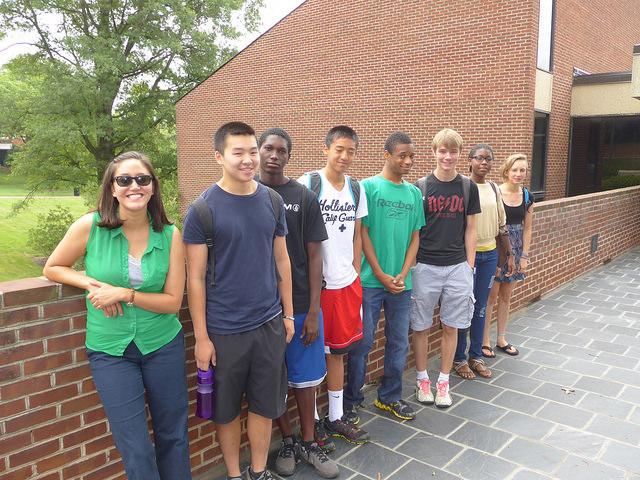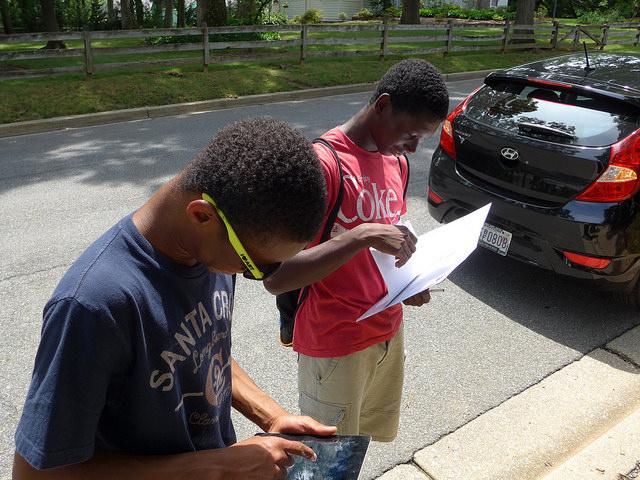Graduate Student Blends Learning and Community to Revamp UMD’s GIS High School Internship
The summer internship has built quite a reputation. Stereotypically synonymous with coffee-fetching and endless hours at a copy machine, summer internships are a rite of passage for young people looking to break into the workforce. In reality, many companies today strive to provide some worthwhile experience for summer interns, with the hope that most students walk away with a small taste of what a specific industry has to offer. But, what if an internship could be more? What if an internship offered the opportunity to become fluent in an in-demand technology and apply that in practice to a meaningful, real-world project? This summer, Urban Studies and Planning graduate student Chelsie Miller led seven high school students from around the region on a six-week internship to help the City of College Park create safer streets using Geographic Information Systems technology. Named “Building Communities through Technology,” the internship provided students an unparalleled experience combining skill acquisition and community service.
Internship Sprouts from a SEED
The internship is an expansion of a GIS training program offered by the National Center for Smart Growth, designed to help area high schoolers jumpstart a rewarding post-graduation career path by teaching them a highly marketable skill. Made possible by a 2011 SEED grant, the original internship was very straightforward: teach students the fundamentals of Geographic Information Systems, an in-demand technology that transforms raw data into maps and reports, providing vital information on everything from disaster relief to traffic patterns. Three years later, as GIS continues to move from a niche technology into the mainstream, the internship has created a flurry of inquiries from students across the region and as far away as Yemen.
Urban Studies and Planning (URSP) Professor Alex Chen, who has an established track record in public school outreach projects for UMD, enlisted the help of Miller this past spring to expand the internship. Together, they hatched the idea of finding a need within the community where the interns could put their new skills to work. They reached out to College Park’s Assistant City Manager, Bill Gardiner—a URSP alum—to explore opportunities, ultimately landing on one of the city’s most pressing action items for their master plan: creating a complete streets map for the city.
“Alex and I have been collaborating on community projects more or less since I graduated, with great results,” said Gardiner, who was also mayor of the City of Hyattsville for eight years. “Given the goals of the summer course, and our needs to collect some background on our street conditions, we thought this was a good way to get that project started.”
Miller selected seven high school juniors and seniors—hailing from Maryland, D.C. and as far away as Ohio—from a pool of 25 applicants to participate in the College Park project. For six weeks, the students engaged in an on-the-ground investigation of six residential streets deemed “priority streets” by College Park, gathering data and transforming that into strengths, weaknesses and recommendations. While GIS remained at the forefront of the experience, Miller brought other technologies into the fold, such as Dreamweaver, GitHub and Flickr, in an effort to create a marketable technology portfolio for the students and to create a more comprehensive end product for College Park. The students then applied their new skills to transform their field data into an interactive, comprehensive and useable online map for the city.
“Chelsie thought we could do much more than a traditional internship and has really ratcheted up with that internship experience can be for students,” said Chen. “She felt strongly that the students should develop some skills and took great pains to make sure they were exposed to the technology and research methodology a project like this entails. In theory, this could have been a three-credit course for college freshmen.”
For most of the students participating this summer, this was their first foray in GIS. Quenten Davis, a charismatic high school junior from Cleveland, Ohio, had never heard of GIS before this internship, but his keen interest in geography provoked him to reach out to UMD. “I wanted to do something productive this summer and stumbled across the internship on Google,” he explains. “I’m learning a lot, making new friends and will hopefully be back to study here at Maryland after graduation.”
An Unlikely Recruiting Tool
Beyond the project experience and comradery, the internship also serves as an unconventional, yet effective, recruitment tool. Miller and Chen organized weekly, informal pizza lunches for the students, hosting a different guest each week from a university college or program. Speakers came from programs like the Honors College, the engineering school and Arts and Humanities. This was completely by design.
“These are incredibly smart, motivated kids,” said Miller. “Introducing them to what a Maryland education can offer is mutually beneficial, so we thought it was a great add-on to the initial experience.”
Added Chen, “They are exactly the type of student we want to attract at the University and it’s a great way to show what Maryland has to offer.”
Mapping their Successes
The students presented their findings, the website and a detailed report to the College Park Department of Planning on the last day of their internship in July, an experience usually reserved for college studio courses. The information gleaned from their work will help shape the future of the city as planners move forward with the project in the coming year.
“The students did a really good job,” said Gardiner. “The product they turned out will allow the consultants we work with in the next phase to get a sense of the quality of the streets in mere minutes. They had a very limited time frame to do this project; it’s really impressive to see such a great end result.”
“Chelsie had the vision for what this opportunity could be,” Said Chen. “Our hope is that her efforts help guide the internship in future years. It’s a great example of what can be done.”



